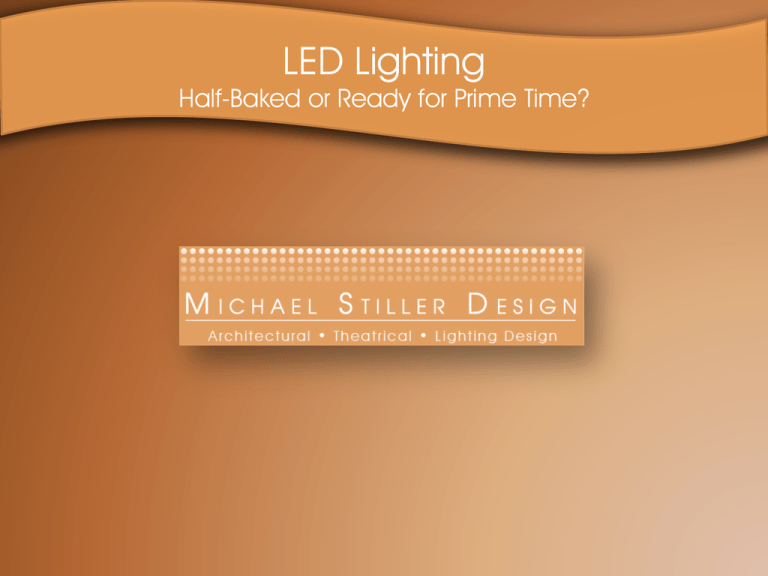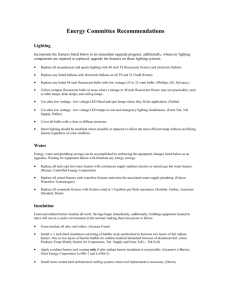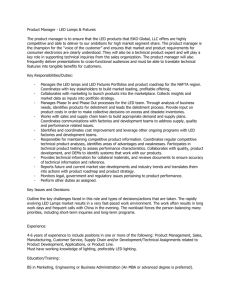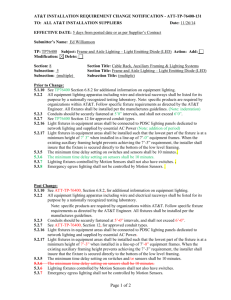LED Lighting Half-Baked or Ready for Prime Time?
advertisement

LED Lighting Half-Baked or Ready for Prime Time? LED Lighting: Half-Baked or Ready for Prime Time? NYSGBC45 / 2011 Learning Units: 1 Credit Designations: LU|HSW|SD This program provides participants with an overview of the knowledge required to choose LED fixtures that are appropriate, efficient, sustainable, and that deliver a high quality of light. Starting with an outline of how light emitting diodes are assembled onto circuit boards and combined with optics, thermal management, and drivers to create a complete system, participants will see first-hand demonstrations as to how the color temperature, CRI, and the LCA of specific fixtures can vary widely from manufacturer to manufacturer, and product to product. Attention will be paid to providing participants with the means to evaluate manufacturer's claims regarding the performance and sustainability of LED lighting fixtures, and to compare these fixtures to equivalent conventional lighting fixtures vis-a-vis their energy efficiency and cost effectiveness. Learning Objectives This seminar will enable participants to: • Compare LED lighting fixtures with regard to color consistency and efficacy . • Specify LED lighting fixtures that are manufactured to the relevant standards as defined by the IES and ANSI. • Analyze the suitability and economic feasibility of specific LED lighting fixtures as replacements for existing conventional lighting. • Identify existing environmental conditions with an eye towards determining how they will affect the performance of LED lighting. LED (SSL) Basics SSL = Solid State Lighting LED = Light Emitting Diodes Typical 5MM LED Indicator Lights, Traffic Signals Line of Sight Applications Typical High Flux LED Lighting Fixtures & other High Brightness Applications LED Basics (Light Emitting Diodes) Electroluminescent Diode From Semiconductors: Chemical Elements or Compounds LED’s are made from various inorganic semi-conductor materials, each producing a different color of light. LED’s are made from various inorganic semi-conductor materials, each producing a different color of light. There’s No Such Thing As A White LED How To Make White Light Then? RGB (Red Green Blue) = Additive Color Mixing System Additive Color Mixing RGB(A) & Other Color Mixing LED Fixtures Can Mix to “White” Issues: • Multi-Colored Shadowing/Fringing & Mixing Artifacts (solved by tri-node LED’s) • LED’s Not True Primary Colors (Mixed White’s Not Pure) Theatrical Lighting: An Early Venue For LED’s Great Light Losses (inefficiency) When Using Colored Filters With Conventional Lighting The Most Common way To Make White Light For Architectural Applications Is By Using a Blue Diode With A Yellow Phosphor High Flux, White LED Components: Die, Reflector, Lens (optics), PC Board (substrate), Thermal Slug Phosphor Applications Conformal Phosphor Remote Phosphor Conventional (Non-Conformal) Phosphor Remote Phosphor • Recovers & Redirects Scattered Light More Efficiently • Enables the use of one phosphor coating for an LED array • Avoids Variables Associated With Applying Phosphor Directly To The Diode/Helps Maintain Color Consistency Color Consistency: How Do We Get There? Chromaticity Chart Showing Planckian Locus: “White Light” ANSI Standard ANSI Standard Specification for LED Chromaticity (Correlates to DOE CFL Specification) Categories Are Defined by Target Color Temperatures Within an Acceptable Range Diode Binning Different LED Manufacturers Define Their Bins Differently Diode Binning Different LED Manufacturers Define Their Bins Differently Bins Are Getting Tighter… Compared to the ANSI 7 Step McAdams Elllipse/CFL Standard …And Tighter… Compared to the ANSI 7 Step McAdams Elllipse/CFL Standard Some Other Causes of Color Variations in LED Lighting Systems Optics • Color shift in lens materials and/or coatings • Electronics • Drive current accuracy and consistency • Color sensor and/or temperature sensor accuracy LED array • Selection of available bins • Temperature variation over board LED Node • Variation in phosphor concentration/layer thickness • Binning versus use temperature • Environmental • Temperature changes (heat buildup) Color Consistency/Uniformity Why Do We Care? CRI (Color Rendering Index) A Useful Metric? Daylight Incandescent LED Fluorescent • Color Rendering Index = the measurement of a light sources ability to accurately render a sampling of different colors, as represented by a scale from 1-100. • Developed in the mid 20th century in response to the advent of fluorescent and HID sources. • High Color Rendering fluorescent lamps are characterized by a CRI of 85 or greater. • CRI is a controversial metric today, especially among the LED lighting community. • Use this metric as a guide, but seeing is believing! Best Way To Judge Color Quality? Plug ‘em in and Turn ‘em on This is White Light? Thermal Management What The Manufacturers Say Philips: Proper thermal design is imperative to keep the LED emitter package below its rated operating temperature. Cree: The majority of LED failure mechanisms are temperature dependent. Elevated junction temperatures cause light output reduction and accelerated chip degradation. Osram: In order to achieve reliability and optimal performance a proper thermal management design is absolutely necessary. Nichia: For high power LED applications, the designer must consider how to manage heat, in order to enhance the performance of the LEDs. If heat management is not considered, the lifetime of the LED will be significantly decreased, or the LED will fail. Thermal Management A Properly Designed Lighting Fixture Will Incorporate All These Elements In Some Form Thermal Management A p–n junction is formed by joining P-type and N-type semiconductors together in close contact. The term junction refers to the boundary where the two regions of the semiconductor meet. Thermal Management Heat Sinks Can Be Hidden From View Or Integrated Into A Fixture’s Exterior Casing. All LED Fixtures Should Feel Warm When Operated For More Than A Few Minutes! Lifetime (Lumen Maintenance) LED’s don’t die, they just fade away. • Useful LED life is defined as the period of time after which the lumen output of the LED source has depreciated to 70% (L70). • Today’s well designed LED fixtures can be expected achieve a useful life of approximately 50,000 hours. • In LED sources, factors that contribute to lumen depreciation include drive current and heat generated within the device. Some white-light LEDs may experience degradation of the phosphor coating . Some LEDs can also suffer from clouding of or impurities in the encapsulant used to cover LED chips. • These conditions vary with the design of different fixtures, the drivers incorporated in each, the fixture’s thermal management, and their method of incorporation within the architecture. It’s A System! Input Wa4age Thermal Manage-­‐ ment LED Chip Lumens Driver Efficiency Fixture Lumens & Life/me Reflector Efficiency LED’s & Absolute Photometry IES LM-80 This IES-approved method describes the procedures to be followed in determining the lumen maintenance of LED light sources. The lighting industry defines LED life as the point in time at which the LED’s are delivering 70% of initial light output. LED manufacturers provide life ratings for individual LED’s at specific drive currents and operating temperatures. (Lumen maintenance is a characteristic measured under controlled conditions. Performance in a particular application may be different.) Ask Your Manufacturer If The Diodes In Their Fixtures Are Tested Under This Standard! LED’s & Absolute Photometry IES LM-79 This IES-approved method describes the procedures to be followed in performing reproducible measurements of the following: 1. total luminous flux (fixture lumens) 2. luminous efficacy (lm/watt) 3. luminous intensity & distribution (candelas) 4. chromaticity, color temperature, color rendering Ask Your Manufacturer If Their Fixtures Are Tested Under This Standard! Photometric Reports The Nuts & Bolts of Your Lighting Fixtures DOE Nutrition Facts LED Efficacy & Color Temperature • LED lighting is currently available in varying color temperatures. • LED lighting efficacies rise with higher (cooler) color temperatures. Lumen Output & Efficacy Efficacy is defined by a ratio of lumens (light output) to watts (electrical input). * Approximately 40-60 lm/w. Higher efficacies achieved with cool vs warm white. ** Late entry experimental chip tested under laboratory conditions. Optics, Lumen Distribution, Fixture Efficiency (relative photometry), & Efficacy No direct comparison between LED’s and sources measured via relative photometry. (What percentage of the available lumens are delivered to their intended targets?) We are now replacing 36w CFL fixtures with 12-20w LED’s & 20w CFL fixtures with 11w LED’s. Today’s LED downlights can give you an energy savings of 85% over incandescent equivalents Optics, Lumen Distribution & Efficacy Same amount of light, distributed over a smaller area, results in increased illuminance It’s All About Design • LED (50 lm/watt) one-to-one retrofit replacing metal halide (Over 70 lm/watt) • Decreased energy consumption from over 4000 Watts to only 500 Watts. • Reduced annual electricity load by 16, 276kwh for a 2.2 year simple payback LED Replacement Lamps? An Engineer’s Frankenstein Monster LED Replacement Lamps? Do these have the same photometrics as the lamps they are designed to replace? How will they work in existing fixtures? • Consider the optical design of the fixture • Consider the venting or lack thereof LED Replacement Lamps? Beware Misleading Claims! 6W Incandescent = 40-50 Lumens, 25W Incandescent = 250 lumens LED Replacement Lamps? The More Information is Better. But Is It The Right Information? 40w Soft White A19 Lamp = 480 lm LED Replacement Lamps? Directional Reflector Lamps = A Better Form Factor The optical characteristics of directional reflector lamps are more closely aligned with those of LED’s. This design is also suited to the accommodation of heat sinks. DOE CALiPER Testing 2008 LED MR16 Light Output Buyer Beware! DOE CALiPER Testing 2008 LED 4’ T8 & T12 Light Output Buyer Beware! DOE CALiPER Testing 2008 LED 4’ T8 & T12 Efficacy Buyer Beware! DOE CALiPER Testing 2010 LED PAR Lamps DOE CALiPER Testing 2010 LED PAR Lamps Examine All Claims, CCT, Equivalencies & Format DOE CALiPER Testing 2010 LED PAR Lamps Good LED Lamp Retrofits Par 20 and larger Formats Par 20 Par 30 But They Often Need To Breathe! (and the good ones are not cheap) Par 38 LED’s & LCA (Modularity & Standardization) How sustainable is it if I have to replace the entire fixture after 50,000 hours? LED’s & LCA (Modularity & Standardization) Replaceable light engines should constitute a minimal amount of materials. Dollars and Sense Yearly Savings for a 10.5 W LED Fixture Replacing a 65 Watt Incandescent Reflector Lamp (Energy Cost $0.15/Kwh) 10 Hours/Day, 5 Days/Week 12 Hours/Day, 6 Days/Week 16 Hours/Day, 6 Days/Week 24 Hours/Day, 7 Days/Week $21.00 $30.00 $41.00 $71.00 Dollars and Sense NYSERDA’s Solid-State Lighting (SSL) Policy becomes effective on June 1, 2010. For covered categories, NYSERDA will accept SSL products (LED light fixtures) listed by ENERGY STAR or appearing on the Design LightsTM Consortium Qualified Products List. If you intend to use LED fixtures as part of your project design, please be sure to work with your manufacturers to determine if the products are qualified. Manufacturers should be directed to the DLC website: www.designlights.org. Next Generation Luminaires Design Competition http://www.ngldc.org/ Qualifying Fixtures Subjected To Independent Judging By Members Of The Architectural & Lighting Design Community LED’s Are Awesome Questions? Small Profile Ever Increasing Energy Efficiency Instant On Dimmable Point Source = Many Optical Configurations Possible No Mercury Long Life







